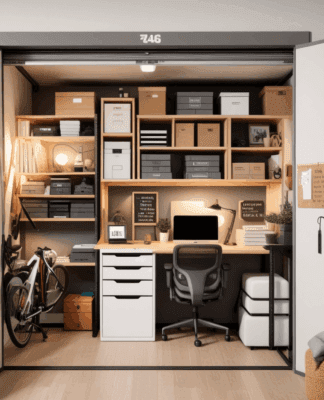Moving to a new home can be exciting, but not many people love the packing part of the journey. Regardless, it’s part of the moving process and needs to get done. Consider some of the following packing tips for moving to help make your transition as seamless as possible.
General Packing Tips for Moving
Trying to pack for a move can be overwhelming at first. Where should you start? What should you put in each box? What should you leave out for later? It’s true; the best way to get it done is to start, but that’s easier said than done. Here are some packing tips to make your move feel a little bit less chaotic.
1. Make a Moving Folder
One of the most underrated moving and packing tips is creating a file for all your important information. This should include rental or purchase papers, utility information, essential contacts, moving contracts, bills, and anything else you can think of. Having a paper version of this on hand can make it easier to stay organized and gives you access to things even if your electronics die or are out of signal.
2. Take Inventory and Consider Downsizing
Before you start packing, take an inventory of all your belongings. Consider which items you’ll need and which may not be necessary in your new home. This is the perfect opportunity to declutter and downsize so you don’t transport clutter in your packing boxes. Go room by room, identifying what you want to keep or no longer need. You can donate items in good condition and toss the rest. Remember, the less you have to pack, the easier and cheaper your move will be.
3. Pack Your Suitcases First
You can save money on moving supplies by filling up all the suitcases in your home first. Packing clothes in suitcases or even heavy items like books can make transporting things from one spot to the next as easy as possible. Apply the same mentality to other containers around the house, as they’re essentially free moving boxes!
4. Choose the Right Moving Boxes
Unless you have a small apartment and a ton of suitcases, you’ll probably also need to invest in some boxes. Invest in various box sizes and types, including specialty boxes for items like wardrobes, dishes, or mirrors. Heavier items should go in smaller boxes, while lighter items like linens and pillows can fill larger boxes. Choosing sturdy, high-quality boxes ensures your belongings remain safe during the move.
5. Don’t Leave Empty Space in Boxes
Empty space in a moving box can increase the likelihood that contents move around and get damaged. You can fill these empty spaces with light objects like towels and rags or packing materials such as styrofoam peanuts or packing paper. Doing so will help keep your items secure and reduce the risk of unnecessary damage when unpacked.
6. Pack by Room
The most efficient way to pack is by organizing your boxes by room. You’ll want to pack your home, starting with the least used room and ending with the most used. While the best order to pack your home will vary based on your needs, we recommend the following:
Basement, garage, and attic
Guest rooms
Living room or dining room
Kitchen (be careful with fragile items)
Bedrooms
Bathrooms
Label the boxes and have the moving companies put them in the corresponding rooms in your new home to make unpacking a breeze. If something is fragile, include a sticker or write “FRAGILE” prominently on the box.
7. Leave Clothes on Hangers
An alternative to folding and packing clothes is to leave them on their hangers and pack them in wardrobe boxes or garbage bags! This can help you save a ton of time and reduce the chance that they’ll be wrinkled along the way.
8. Add Extra Padding
Add extra padding with bubble wrap, packing paper, and blankets when packing breakables like glassware, electronics, or ceramics. Double-wrap particularly delicate items and consider placing them in smaller boxes for added protection.
9. Use Box Dividers for Glasses and Dinnerware
If you have a lot of glasses to pack, consider getting some box dividers to help keep things secure when the moving crew comes. The dividers can easily be put inside a box and help prevent each item from knocking against each other during transit.
10. Empty or Secure Drawers
If you have lightweight items in drawers, secure them with plastic wrap or packing tape to prevent shifting. For heavier or loose items, empty the drawers to avoid damage to the furniture or injury while carrying.
11. Pack Electronics and Appliances With Care Strategically
Start by taking photos of your electronics’ wiring setup before disconnecting anything. This will make reassembly easier when you unpack. Use original packaging for electronics whenever possible, as these boxes are specifically designed to keep items safe. If the original boxes aren’t available, wrap devices like TVs, computers, and gaming systems in anti-static bubble wrap to prevent damage. Place cables, chargers, and any small item accessories in clearly labeled bags, and tape them to their corresponding electronics so nothing gets lost.
When packing appliances like microwaves, blenders, or toasters, clean them thoroughly to prevent odors or debris during transit. Remove any detachable parts, wrap them separately, and secure loose cords with zip ties or tape. Place appliances upright in sturdy boxes, padding them with towels, foam, or bubble wrap to keep them stable during the move.
12. Keep Things Aside for Moving Day
Set aside a dedicated box or bag for all the essentials you and your family will need on moving day. This includes items like snacks, bottled water, medications, important documents, phone chargers, toiletries, pajamas, and basic cleaning supplies. Think of it as a “survival kit” to get you through the moving chaos and ensure you don’t have to dig through boxes for things you need immediately. Don’t forget to include things like toilet paper, pots and pans, and pillows.
It’s also helpful to pack a small “comfort box” for each family member, including a favorite book, blanket, toy, or other personal items that will help make those first few nights in the new home feel cozier and more familiar.
A Creative Packing Tip for Moving Houses Across the Country
One great cross-country moving tip is shipping items you want to purchase to your home so they are scheduled to arrive when you arrive. For example, say you decided that your move was the perfect time to get new mattresses or update your furniture. If you know what you want and how it will fit in the house, order it online and have it delivered so it arrives when you get there. This can help save you precious time whether you’re moving to a neighboring state or the other side of the country. Plus, since you’ll have fewer items, you’ll save money on a moving vehicle or professional crew.
Packing Tips for Moving in a Hurry
Making a last-minute move can be even more stressful because the timeline is often considerably shorter. Here are some helpful packing tips for moving on a deadline:
Find a good moving checklist online to help ensure that you don’t miss any important steps.
Get rid of as many things as possible before
Make sure you have plenty of packing supplies for all of your belongings.
Try to take some time off work so you can focus on packing.
Start packing up any unused rooms as soon as possible.
Hire professional movers or reserve a moving truck. You can also consider a moving service like PODs if you’re moving out of state.
A Few Extra Tips for Packing and Moving With Children and Pets
Packing and moving with children and/or pets brings another layer to the challenges of this transition. Depending on the age of your kids, it can be hard to care for them while packing and trying to console their grief about leaving all at the same time. However, a little extra effort makes all the difference. Here are some tips to help you successfully move with kids, pets, or a mixture of both.
Give everyone some time to feel sad and grieve the home and neighborhood you’re leaving behind.
Try to create positive things to look forward to.
Let your children help pick out things for their new rooms.
Start doing fun activities as soon as you’re in your new neighborhood.
Make sure your children have comfort items in an easily accessible bag or backpack.
If moving with pets, keep some of their favorite toys and comfort items at hand to help ease the transition.
Take pets on walks and give them some extra attention whenever possible.
To help supplement your move, partner with The Lock Up Self Storage today. With every new self-storage unit rental, The Lock Up offers a free moving truck and free locks. Each truck features a 12-foot box with blankets and dollies, free of cost. Although moving trucks are subject to reservation and self-storage location, it’s a great way to help offset costs and aid in your move. To find a facility near you, contact The Lock Up today at 1-866-327-LOCK or find a unit online.



















